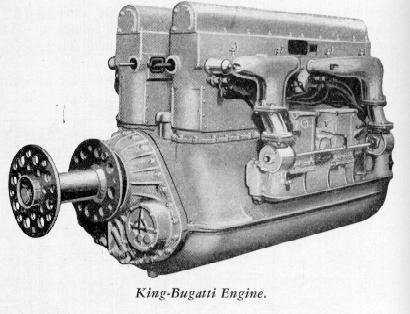 | ||
The Bugatti U-16 was a 16-cylinder water-cooled double-8 vertical in-line "U engine", designed by Ettore Bugatti in 1915-1916 and built in France in small numbers. The US Bolling Commission bought a license to build the engine in the US, and small numbers of a slightly revised version were built by the Duesenberg Motor Corporation as the King-Bugatti. Probably about 40 King-Bugattis were made before the end of World War I caused building contracts to be canceled.
Contents
Design and development
The U-16 engine was designed to use as many features of a previous Bugatti 8-cylinder in-line engine as possible. Two eight-cylinder banks were mounted vertically side by side on a common cast aluminium crankcase, each bank driving its own crankshaft. The two crankshafts were geared to and drove a single common airscrew shaft. The shaft was bored to accept a 37-mm gun barrel, and a clear passage was provided through the crankcase in line with the shaft boring for the same purpose. Each eight-cylinder bank was made up of two cast iron four-cylinder blocks; the crankshafts were each made up of two standard four-cylinder crankshafts joined end to end by a fine taper cone joint. To reduce overall length, these crankshafts were undercut: a typical Bugatti approach, where only their unlimited budget and attention to detail could afford such complexities.
A bevel gear at the junction drove a vertical shaft from which the single overhead camshaft and dual magnetos for each bank were driven. Two magnetos were mounted on the outside of each cylinder bank. Each magneto fired all eight cylinders for that bank, driven by bevel gear from the vertical shaft that also drove the bank's single overhead camshaft. Each cylinder had two vertical inlet valves and a single vertical exhaust valve, all driven by rocking levers from the camshaft. Four carburettors each fed four cylinders via a water jacketed manifold. Each cylinder exhausted into an individual pipe in the space between the cylinder blocks. The whole construction was protected by patents until 1935.
The engine completed ten-hour and fifty-hour endurance tests in 1917, and the French government purchased a license and arranged for production by Peugeot. During the fifty-hour test a US sergeant who was observing the test for the Bolling Commission was killed by the propeller, becoming the first US serviceman to die on active service during World War I.
The Bolling Commission and the "Bugatti mission"
In 1917 a US military mission headed by Colonel R.C. Bolling visited Europe to choose aero engines to be produced for the Aviation Section, Signal Corps. The mission was accompanied by a group of civilian experts headed by the engine manufacturer Howard Marmon. The Bugatti U-16 aroused interest and Marmon arranged for a license to be purchased for $100,000 by the US government. In December 1917 a "Bugatti Mission" sailed from Bordeaux for the US to supervise production of the engine at the Duesenberg Motor Corporation of Elizabeth, New Jersey, where the engines were planned to be made.
US revisions
The US government engaged one Colonel Charles B. King to redesign the engine for production in the US, much to Ettore Bugatti's irritation. Col. King did not approve of some of the detail design of the engine, such as the lack of water cooling around the valve seats and the close pitch of valves. Accordingly King's revisions to the design altered the cylinder heads to provide freer water circulation, better valve cooling, and a slight increase in the distance between valve centres.
Post World War I developments
Neither Bugatti's U-16 or the King-Bugatti were particularly successful engines. Few were installed in aircraft, and even fewer actually flew. After World War I no further developments were made in the US, while in France Breguet took over the license and continued development under the designation "Type U-24". In 1920 Breguet showed a "quadrimoteur" made of two Type U-24s coupled together, with provision to declutch any cylinder bank to enable it to be stopped while the other three units continued to provide power.
Variants
Breguet
Applications
Engines on display
The Musee de l'air at Chalais-Meudon, 2 rue des Vertugadins, Meudon (just outside the Paris boundaries in the south west direction) holds a French U-16 engine and two Breguet-Bugatti engines. A King-Bugatti can be seen at the National Air Museum of the Smithsonian Institution in Washington D.C., and another in the USAF museum at the Wright-Patterson AF Base at Fairborn, Ohio. The Auburn-Cord-Duesenberg Museum in Auburn, Indiana also has a King-Bugatti engine on display in their Hall of Technology
Specifications (King-Bugatti)
Data from Jane's except where indicated. Later specifications quote slightly varied detail dimensions and increased horsepower ratings.
